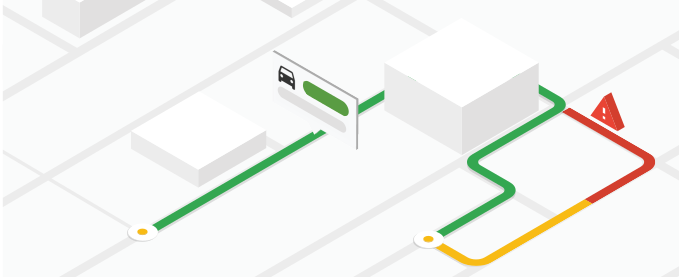
Directions API का इस्तेमाल क्यों करें
Directions API की मदद से, यात्रा के कई तरीकों के लिए निर्देश पाए जा सकते हैं. जैसे, बस, मेट्रो वगैरह से यात्रा करना, ड्राइविंग, पैदल चलना या साइकल चलाना.
Directions API का इस्तेमाल करके क्या-क्या किया जा सकता है?
Directions API की मदद से, जगहों के बीच के दिशा-निर्देशों का हिसाब लगाया जा सकता है. इसमें यह जानकारी भी शामिल होती है:
- बस, मेट्रो वगैरह से, कार से, पैदल चलकर या साइकल चलाकर जाने के लिए रास्ते की जानकारी.
- बीच में रुकने की जगहों की सीरीज़ का इस्तेमाल करके, कई हिस्सों में बंटे दिशा-निर्देश.
- शुरुआत की जगह, मंज़िल, और वेपॉइंट को कई तरीकों से तय करें. जैसे, टेक्स्ट स्ट्रिंग ("शिकागो, इलिनॉय" या "डार्विन, नॉर्दर्न टेरिटरी, ऑस्ट्रेलिया"), जगह के आईडी या अक्षांश/देशांतर निर्देशांक.
Directions API कैसे काम करता है
रास्ता तय करते समय, Directions API सबसे कम खपत वाले रास्ते दिखाता है. सबसे सही रास्ता तय करते समय, यह प्रॉडक्ट यात्रा से जुड़ी इन बातों का ध्यान रखता है:
- यात्रा में लगने वाला समय (मुख्य)
- दूरी
- टर्न की संख्या
यहां दिए गए अनुरोध के उदाहरण में, टोरंटो, ओंटारियो से मॉन्ट्रियल, क्यूबेक तक के ड्राइविंग निर्देशों को JSON फ़ॉर्मैट में दिखाया गया है:
https://maps.googleapis.com/maps/api/directions/json ?destination=Montreal &origin=Toronto &key=YOUR_API_KEY
संसाधन
नीचे दी गई टेबल में, Directions API के ज़रिए उपलब्ध संसाधनों की खास जानकारी दी गई है. साथ ही, यह भी बताया गया है कि इन संसाधनों से किस तरह का डेटा मिलता है.
| डेटा संसाधन | डेटा वापस लाया गया | जवाब का फ़ॉर्मैट |
|---|---|---|
| रास्ता
जगह के आईडी, पतों या अक्षांश/देशांतर निर्देशांकों के तौर पर, सप्लाई के मूल और गंतव्य की जानकारी दें. विवरण के लिए आवश्यक पैरामीटर देखें. |
विस्तृत दिशा-निर्देश, मार्ग, चरण और चरणों में विभाजित. विवरण के लिए दिशानिर्देश प्रतिक्रियाएँ देखें. |
|
Directions API का इस्तेमाल कैसे करें
| 1 | सेट अप करें. | अपना Google क्लाउड प्रोजेक्ट सेट अप करें से शुरुआत करें और आगे दिए गए सेटअप निर्देशों को पूरा करें. |
| 2 | डेमो आज़माएं | एक बार जब आपके पास API कुंजी और क्लाउड प्रोजेक्ट हो जाए तो आप बिना किसी शुल्क के दिशानिर्देश डेमो आज़मा सकते हैं. दिशानिर्देश API डेमो देखें. |
| 3 | अनुरोध बनाएँ | उदाहरण अनुरोधों को देखें और उपलब्ध विकल्पों के बारे में जानें, जैसे यात्रा मोड, वेपॉइंट और मार्ग प्रतिबंध. दिशानिर्देशों के उदाहरण देखें. |
| 4 | जवाब देने से जुड़ी बुनियादी बातें समझना | अपने ऐप्लिकेशन के लिए दिशा-निर्देशों का डेटा इस्तेमाल करने की तैयारी करने के लिए, डेटा रिस्पॉन्स एक्सप्लोर करें. ज़्यादा जानकारी के लिए, दिशा-निर्देशों के रिस्पॉन्स देखें. |
| 5 | अपने ऐप्लिकेशन में दिशा-निर्देशों से जुड़ा डेटा शामिल करें! | इस डेटा का इस्तेमाल, यात्रा की दूरी और समय का हिसाब लगाने के लिए किया जा सकता है. |
उपलब्ध क्लाइंट लाइब्रेरी
इस एपीआई को अपनी पसंद की भाषा में कॉल करें. इसके लिए, इनमें से किसी एक क्लाइंट लाइब्रेरी का इस्तेमाल करें:
- Google Maps Services के लिए Java क्लाइंट
- Python Client for Google Maps Services
- Google Maps Services के लिए Go Client
- Google Maps की सेवाओं के लिए Node.js क्लाइंट
Google Maps Services के लिए Java Client, Python Client, Go Client, और Node.js Client, कम्यूनिटी की ओर से सपोर्ट की जाने वाली क्लाइंट लाइब्रेरी हैं. इन्हें Apache 2.0 License के तहत ओपन सोर्स किया गया है. इन्हें GitHub से डाउनलोड करें. यहां आपको इंस्टॉल करने के निर्देश और सैंपल कोड भी मिल सकता है.
आगे क्या करना है
- Directions API का इस्तेमाल शुरू करना: शुरू करें पर जाएं.
- निर्देश पाने के अनुरोध करना शुरू करें: निर्देश पाएं पर जाएं.
- सबसे सही तरीके अपनाएं: वेब सेवा के सबसे सही तरीके पर जाएं.

